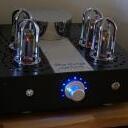Search the Community
Showing results for tags 'ceramic heatsinks'.
-
Cases and heatsinks are a problem for DIY builds. Front panels of thick alloy need machining and tapping as do heatsinks. These items are hard to get machined or the sizes the builder wants are not available. I devised a way of making cases, which eliminated these problems and made for easier case design, lower costs and quicker builds. Cases Made from sheet aluminium alloy of preferably 3mm so only single sheet of material needed. I get the parts laser cut by a company which will also supply the material. The case parts need holes to be countersunk where necessary and are then taken for surface finishing, (bead blasting and anodising in my case). I then take the front panels to be screen printed with the graphics I provide. The assembly is with corner posts and angle brackets cut and drilled, and bolted together. I only drill and tap corner posts to attach base and top panels. The case is basically a box with a front panel on to cover the front of the box. Heatsinks https://uk.farnell.com/amec-thermasol/fch505010t/heat-sink-50mmx50mmx10-25mm-ceramic/dp/2499023 Edit; a link to these was omitted, http://www.amecuk.co.uk/ Element14 has them in many countries. https://www.newark.com/c/cooling-thermal-management/heat-sinks?brand=amec-thermasol I discovered porous ceramic heatsinks and realised that these small, light, self-adhesive items would solve problems. I bought a few and tested to see if they did what was claimed. A single 50mm square of 10mm thick could dissipate 5-10W stuck on sheet aluminium. To make heatsinks you only have to bolt the semiconductors directly to the 3mm plates and place the ceramic heatsinks as needed. They are not expensive, and with a range of sizes you can arrange heatsinks of different shapes. I was concerned that they might unstick but the opposite has been true, they are hard to remove. They are not pretty so I contain them inside the case and organise slots above and below to act as a chimney to allow convection. This works well and they do not run hot. The porous ceramic devices are very effective. I have found that this method is much easier to procure and build. The amplifiers built this way can be smaller and lighter.




